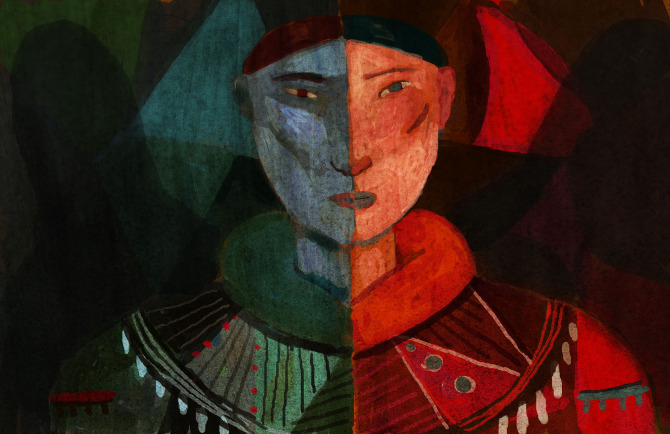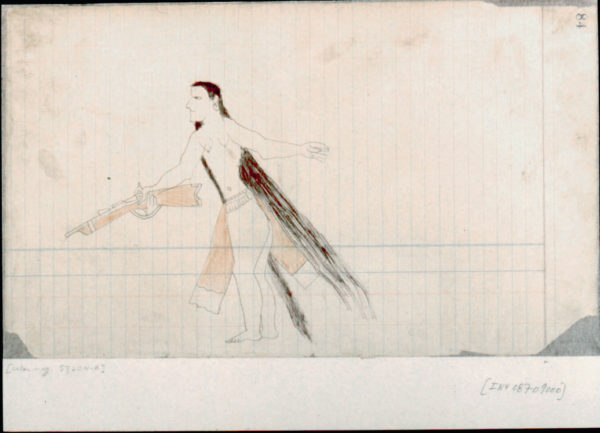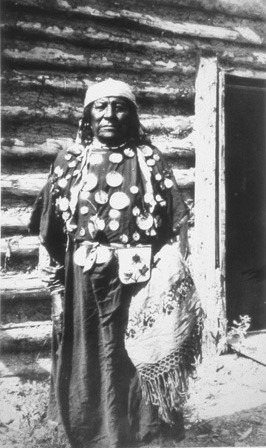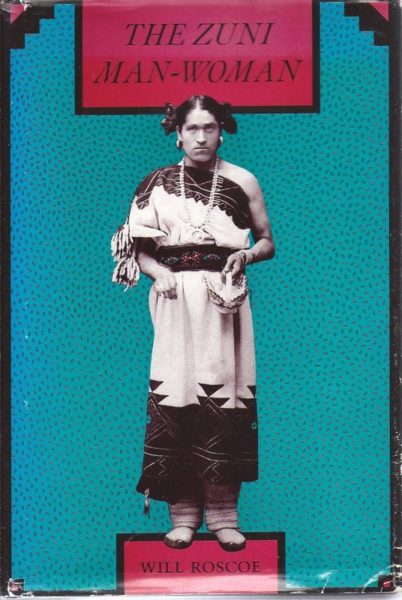
09 Mai two spirits- Find Them and Kill Them ©carine roth
La bispiritualité (two-spirit en anglais) est un terme dérivé d’un concept anishinaabeg (ojibwé) appelé niizh manidoowag, qui réfère aux personnes s’identifiant comme ayant un esprit masculin et un esprit féminin.

la bispiritualité sert aussi à désigner l’identité spirituelle. Dans plusieurs communautés autochtones, on croit souvent que les personnes bispirituelles communiquent, par l’intermédiaire de rêves et de visions, avec des forces surnaturelles. En tant que telles, elles occupent souvent des rôles spirituels spéciaux, comme ceux de chamans, de guérisseurs ou chef spirituel.
De tout temps, les personnes bispirituelles sont aussi gardiennes des traditions et conteuses des histoires de la création et, de ce fait, de grandes sources de connaissances.
©thecanadianencyclopedia.ca
The spiritual dimension of alternative gender roles varied in different tribal belief systems. Among Plainstribes, characterized by what anthropologists term a “vision complex,” dreams and visions defined one’s identity and imparted luck, talents, insights, and power. ©Will Roscoe

Les langues des tribus indigènes nord-américaines disposent de leurs propres termes, par exemple wíŋkte en lakota, nádleehé en navajo et hwame en mojave.
Parfois il leur est attribué des rôles particuliers dans la tribu, entre autres :
- transmettre l’histoire orale ;
- voir l’avenir ;
- donner les prénoms ;
- créer la poterie ;
- organiser les mariages ;
- créer les coiffes de plumes.
©wikipedia
The Two Spirit term is sometimes referenced more abstractly to indicate two contrasting spirits such as “Warrior and Clan Mother” or “Eagle and Coyote.”

Osh-Tisch, or ‘Finds Them and Kills Them’, was a spiritual leader and warrior of the Crow Nation who lived in the late 18th and early 19th centuries.
“The New World.” This romanticized term inspired legions of Europeans to race to the places we live in search of freedoms from oppressive regimes or treasures that would be claimed in the name of some European nation.
Those who arrived in the Native American Garden of Eden had never seen a land so uncorrupted.
The Europeans saw new geography, new plants, new animals, but the most perplexing curiosity to these people were the Original Peoples and our ways of life. Of all of the foreign life ways Indians held, one of the first the Europeans targeted for elimination was the Two Spirit tradition among Native American cultures. At the point of contact, all Native American societies acknowledged three to five gender roles: Female, male, Two Spirit female, Two Spirit male and transgendered.
LGBT Native Americans wanting to be identified within their respective tribes and not grouped with other races officially adopted the term “Two Spirit” from the Ojibwe language in Winnipeg, Manitoba, 1989. Each tribe has their own specific term, but there was a need for a universal term that the general population could understand. The Navajo refer to Two Spirits as Nádleehí (one who is transformed), among the Lakota is Winkté (indicative of a male who has a compulsion to behave as a female), Niizh Manidoowag (two spirit) in Ojibwe, Hemaneh (half man, half woman) in Cheyenne, to name a few. As the purpose of “Two Spirit” is to be used as a universal term in the English language, it is not always translatable with the same meaning in Native languages. For example, in the Iroquois Cherokee language, there is no way to translate the term, but the Cherokee do have gender variance terms for “women who feel like men” and vice versa.
Old Prejudices In The New World
The Jesuits and French explorers told stories of Native American men who had “Given to sin” and “Hunting Women” with wives and later, the British returned to England with similar accounts. George Catlin said that the Two Spirit tradition among Native Americans “Must be extinguished before it can be more fully recorded.” In keeping with European prejudices held against Natives, the Spanish Catholic monks destroyed most of the Aztec codices to eradicate traditional Native beliefs and history, including those that told of the Two Spirit tradition. In 1530, the Spanish explorer Cabeza de Vaca wrote in his diary of seeing “soft” Native Indian males in Florida tribes dressing and working as women. Just as with all other aspects of the European regard for Indians, gender variance was not tolerated. Europeans and eventually Euro-Americans demanded all people conform to their prescribed two gender roles.
The Native American belief is that some people are born with the spirits of both genders and express them so perfectly. It is if they have two spirits in one body. Some Siouan tribes believed that before a child is born its soul stands before The Creator, to either reach for the bow and arrows that would indicate the role of a man or the basket that would determine the role of a female. When the child would reach for the gender-corresponding hand, sometimes The Creator would switch hands and the child would have chosen the opposite gender’s role and therefore casting its lot in life.
Native Americans traditionally assign no moral gradient to love or sexuality; a person was judged for their contributions to their tribe and for their character. It was also a custom for parents to not interfere with nature and so among some tribes, children wore gender-neutral clothes until they reached an age where they decided for themselves which path they would walk and the appropriate ceremonies followed. The Two Spirit people in pre-contact Native America were highly revered and families that included them were considered lucky. Indians believed that a person who was able to see the world through the eyes of both genders at the same time was a gift from The Creator. Traditionally, Two Spirit people held positions within their tribes that earned them great respect, such as Medicine Men/Women, shamans, visionaries, mystics, conjurers, keepers of the tribe’s oral traditions, conferrers of lucky names for children and adults (it has been said that Crazy Horse received his name from a Winkte), nurses during war expeditions, cooks, matchmakers and marriage counselors, jewelry/feather regalia makers, potters, weavers, singers/artists in addition to adopting orphaned children and tending to the elderly. Female-bodied Two Spirits were hunters, warriors, engaged in what was typically men’s work and by all accounts, were always fearless.
Traditional Native Americans closely associate two spirited people with having a high functioning intellect (possibly from a life of self-questioning), keen artistic skills and an exceptional capacity for compassion. Rather than being social dead-enders as within Euro-American culture today, they were allowed to fully participate within traditional tribal social structures.
Two Spirit people, specifically male-bodied (biologically male, gender female) could go to war and have access to male activities such as the sweat lodge. However, they also took on female roles such as cooking, cleaning and other domestic responsibilities. Female bodied (biologically female, gender male) Two Spirits usually only had relationships or marriages with females and among the Lakota, they would sometimes enter into a relationship with a female whose husband had died. As male-bodied Two Spirits regarded each other as “sisters,” it is speculated that it may have been seen as incestuous for Two Spirits to have a relationship with each other. Within this culture it was considered highly offensive to approach a Two Spirit for the purpose of them performing the traditional role of their biological gender.
« Finds Them and Kills Them »
Osh-Tisch, also known as Finds Them and Kills Them, was a Crow Two Spirit and was celebrated among his tribe for his bravery when he attacked a Lakota war party and saved a fellow tribesman in the Battle of the Rosebud on June 17, 1876. In 1982, Crow elders told ethnohistorian Walter Williams: “The Two Spirits were a respected social group among the Crow. They spent their time with the women or among themselves, setting up their tipis in a separate area of the village. They called each other ‘sister’ and saw Osh-Tisch as their leader.” The elders also told the story of former B.I.A. agents who tried to repeatedly force him to wear men’s clothing, but the other Indians protested against this, saying it was against his nature. Joe Medicine Crow told Williams: “One agent in the late 1890’s…tried to interfere with Osh-Tisch, who was the most respected Two Spirit . The agent incarcerated the Two Spirits, cut off their hair, made them wear men’s clothing. He forced them to do manual labor, planting these trees that you see here on the B.I.A. grounds. The people were so upset with this that Chief Pretty Eagle came into Crow agency and told the agent to leave the reservation. It was a tragedy, trying to change them.”
Pressure to change also came from Christian missionaries. In 1903 a Baptist minister arrived on the reservation. According to Thomas Yellow Tail, “He condemned our traditions, including the Two Spirit. He told his congregation to stay away from Osh-Tisch and others. He continued to condemn Osh-Tisch until his death. That may be the reason no others took up the Badé role after Osh-Tisch died.”
On February 11, 1712, Colonel Barnwell of South Carolina attacked the Tuscaroras at Narhantes, a Tuscarora fort on the Neuse River, North Carolina. Barnwell’s troops were surprised to find that the most fierce of the Tuscarora warriors were women who do not surrender “until most of them are put to the sword.” It was an Iroquois custom to put Two Spirits on the front lines to scare the enemy. A warrior woman and man in women’s clothes were as frightening to Euro-Americans then as they are now. John Lawson wrote of the Tuscarora: “During their move to winter hunting quarters, women carried grain and other provisions. After arriving, most of their time was spent in getting firewood, cooking and making craft items. Men who were poor hunters, possibly berdaches, procured bark for the cabins, ran errands back to the town where the old people were left, made wooden bowls and dishes and clay tobacco pipes.” By the early 1900s, it had been claimed that there were no alternative genders among the Six Nations Iroquois/Haudenosaunee, despite documentation and oral histories. Most, if not all tribes had been influenced by European prejudices.
Colonization Takes Its Toll
As Europeans forced their way into North America, colonial governments eagerly formed white power structures, land grabbed from Natives and implemented the genocidal conversion tactics that has defined the relationship between Native Americans and Euro-American governments. When Christopher Colomb encountered the Two Spirit people, he and his crew threw them into pits with their war dogs and were torn limb from limb. The inhuman treatment Christians offered was only the beginning of the Native Holocaust.
As Europeans and subsequently Euro-Americans moved from east to west, they spread diseases and imposed European culture and religions onto Natives. In the 20th century, as neurotic prejudices, instigated by Christian influences, increased among Native Americans, acceptance of gender diversity and androgynous persons sharply declined. Two Spirits were commonly forced by government officials, Christian representatives or even their assimilated Native communities to conform to standardized gender roles. Those who felt they could not make this transition either went underground or committed suicide. The imposition of Euro-American marriage laws invalidated the same-gender marriages that were once common among tribes across North America. The Native American cultural pride revivals that began in the 1960s / Red Power movements brought about a new awareness of the Two Spirit tradition and has since inspired a gradual increase of acceptance and respect for gender variance within tribal communities. It was out of this new tribal and self respect that encouraged the shedding of the offensive “Berdache” term that was assigned by Europeans.
I will leave the last words to the late Lakota actor, Native rights activist and American Indian Movement co-founder Russell Means: “In my culture we have people who dress half-man, half-woman. Winkte, we call them in our language. If you are Winkte, that is an honorable term and you are a special human being and among my nation and all Plains people, we consider you a teacher of our children and are proud of what and who you are.”
©indiancountrytoday



Perhaps one of the most famous Two Spirits of the past was We’wha (1849-1896), of the Zuni nation. We’wha was biologically a male and engendered with a female spirit. By all accounts, she was a very intelligent person who became the Zuni Ambassador in Washington, D.C. and was celebrated by the Washington elite as “The Zuni man-woman.” This photo depicts We’wha in traditional Zuni female clothes.
“Find Them and Kill Them”
Un Etre Two Spirits
Toutes ces conventions, cette bêtise, torture mental et psychologique, interprétations et perte de sens…
Nous voulons changer cette société pour un monde meilleur et plus libre, plus doux, plus harmonieux, mais avant tout un monde qui connaisse l’amour et non l’idée de l’amour et non la dépendance affective, les projections, incompréhensions, jugements, peurs. Commencer par soi, sans se perdre dans la bêtise des étiquettes et conventions sclérosées et stériles. Si tu me nommes tu me nies. Queer space et révolution. Cette espace n’est pas un lieu de souffrance mais un espace de libération. Nous ne parlons pas de psychologie mais de spiritualité et de risques, de créer, ensemble. Avancer, ensemble. Se tromper et recommencer, ensemble. On ne peut faire disparaitre personne. On ne peut rien oublier ni nier. Seulement décider de quelle histoire je porte au passé et lègue aux ancêtres futurs. Travail de fond. Nécessaire. Maintenant.
Affronter. Voir en face. Courage, responsabilité et sincérité. Regarder les ombres comme la lumière. Oser être avec ce qui est plutôt que s’en protéger et le fuir. Oser aussi et surtout l’accueillir, lui faire une place plutôt que le rejeter, nier, exclure, rendre invisible. L’accueillir au lieu de le juger. Tout est bienvenu. Tout a sa place, de toi et en toi. Système qui veut supprimer et qualifier. Système binaire oppressant de ce qui est juste et ce qui est faux, ce qui est vrais et ce qui devrait ou aurait dû être autrement. Faire Paix. C’est plus que nécessaire. C’est urgent.
Intégral, intégratif, apprendre, changer, oser le grand tout, le généreux et sans retenue.
Ce changement commence par soi même. Faire face à mes peurs, manques, pertes et trouver le lieu de fierté et d’intégrité. Honte ou fierté, rien entre deux. L’un ou l’autre. L’un et l’Autre. Decision road.
Apprendre à aimer, soi-même, l’autre, l’inconnu, l’étranger, le désagréable, ce qui déstabilise, ce qui ne sait pas, ce qui ignore et trébuche, cette enigme et absolu mystère qu’est et sera toujours l’Autre. Et le beloved, l’être chéri et désiré, celui qui a ta préférence sans exclure personne. Celui qui te complète et pourtant diffère.
S’affranchir de soi-même pour se découvrir vraiment. Vaste espaces sauvages du coeur et de l’âme humaine… Petits cailloux sur le chemin… Poussière d’étoiles, tombés du ciel ici bas, imperfection, tension des opposées, contradictions, incohérences, la taille de nos âmes… Et pourtant, la taille de nos âmes…La taille de nos âmes, pourtant.
Mon guide m’offre une paire de ciseaux. Couper, laisser partir et se libérer. Condition au neuf non encore advenu.
“we need space to wander”… 🐾🐾🐾🐾🐾🐾🐾🐾


